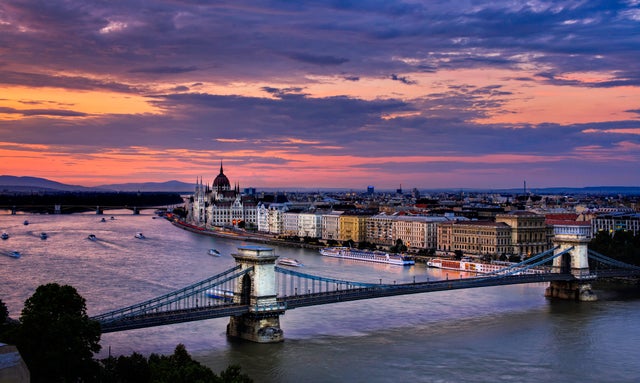8 things to know for your first trip to Europe
8 things to know for your first trip to Europe

If you’re traveling from the US or Canada, you won’t need a visa to visit Europe—but you do need a valid passport. If you’ve already got one, check the expiration date and make sure it’ll still be valid for at least six months after your trip. If you need a passport or have to renew yours, start the process as soon as possible!
2. Currency exchange and using credit cards
Many countries in Europe use the euro, but a few popular destinations—like England, Sweden, and Switzerland—don’t. So, it’s a good idea to check out the currency info in your “Tour FAQ” before exchanging any money. Some travelers like to have a little cash on hand before their trip, just in case. You can also use your debit card at international ATMs, which you can find and airports, hotels, and banks in your destination—just remember that your bank may charge a small fee for foreign transactions.
As far as credit cards go, Master Card and Visa are widely accepted in Europe. Many major cards waive foreign transaction fees, but double-check your policy before you plan to use it!
Need more tips on exchanging currency for your first trip to Europe? Check out our post here.
3. Learn the language (just a little!)
You don’t need to be fluent in French or Swedish to get by on your first trip to Europe. Many Europeans speak very good English, especially in major cities, but knowing a few key phrases is a good way to connect with locals and get immersed in the culture. Brush up on your German, French, Spanish, and Italian before you go!
4. Pack smart for your trip
The best packing advice for any trip is always to pack light. You shouldn’t bring more than one checked bag and one carry-on for your first trip to Europe; you may be taking train rides, ferries, or other plane rides where you won’t want lots of luggage with you.
Our experts recommend packing light layers, bringing clothes you can plan to re-wear, and saving a little room in your suitcase for souvenirs! Need more packing tips for your first trip to Europe? Check out all our packing advice here.
5. Get a power adapter
You’ll need a power adapter if you want to charge your phone or use any of your own electronics during your trip. A power adapter lets you use foreign outlets, while a converter will change the voltage if your electronics require different power. In Europe, most outlets are C, E, and F type with two or three prongs. Not sure what you’ll need? Check out our detailed guide to power adapters and converters for your trip.
6. Beat jet lag
A lot of travelers worry about jet lag for their first trip to Europe, and while it’s definitely an issue the good news is that it’s easy to beat with a little preparation. First, try and sleep as much as you can on the plane. When you arrive, set your watch to your destination’s local time. Go for a walk, grab a coffee, and keep busy until bedtime—staying up will help you snap into a regular routine in no time!
Check out all our tips for fighting jet lag on your first trip to Europe.
7. Stay connected in Europe
Many wireless carriers offer international phone plans, but they can be expensive. When our team travels to Europe, connecting to local Wi-Fi and staying on airport mode to avoid charges is a popular option. But there are other ways to stay connected, including purchasing an international SIM card. Check out all our tips for using your phone abroad!
If you’re worried about getting lost and not having internet access, don’t sweat! With Google Maps, you can download maps of your destination to use even when you’re offline.
8. When is the best time to visit Europe?
Now that you’re prepared for your first trip to Europe, the only question left is: When is the best time to go? The good news is that Europe dazzles all year long, whether it’s summertime along the Mediterranean or winter at a Christmas market. But one of our team’s favorite times to visit is during the off-season, when there are fewer crowds and comfortable weather—just to name a few!
Do you have any Europe travel tips? Share them with us on Facebook!
10 things you need to know before your first trip to Europe
Devorah Lev-Tov is a contributing writer to TPG and TPG Family, as well as Travel + Leisure, Afar, Robb Report and The New York Times. She lives in Brooklyn with her husband and young son and travels everywhere from Bolivia to Hong Kong to Tel Aviv.

This post contains references to products from one or more of our advertisers. We may receive compensation when you click on links to those products. Terms apply to the offers listed on this page. For an explanation of our Advertising Policy, visit this page.
Update: Some offers mentioned below are no longer available. View the current offers here.
Update: The Wells Fargo Propel American Express® card is no longer open to new applications. View the current offers here.
Some of us first go to Europe as study-abroad students, but many of us never make it across the Atlantic until later in life. I was one of those latecomers, arriving in Europe for the first time in my late 20s.
I’ve been dozens of times since then, but no matter how often you explore Europe, or whether you do it alone, as a couple, with friends or with your family, the first time is always the most exciting and memorable. Europe can be overwhelming, but figuring out how to make the most of your trip is not impossible. These tips will help ensure your first trip to Europe goes smoothly — and that you’ll go back again.
Pick which city to fly into by comparing costs
Europe is small compared to the U.S. and it’s easy to land in one country and go visit others by train or cheap, short flights. Pick a region of continental Europe — western, central, eastern — or the U.K., and then choose your destination city because flights there are the cheapest. Be careful, however, of low-cost carriers which charge for extras like bags, seat choice and water.
Airlines flying to certain cities like Dublin or Kraków, which is one of TPG’s 20 hottest travel destinations of 2020), are known for having low fares, or offering tickets for very few miles or points. But be careful — some airlines, like British Airways and Virgin Atlantic, may not charge a lot of miles to get to London but often charge astronomical taxes and fuel surcharges, so be sure to check all airlines for the best deal. And watch for award-redemption deals. Business-class flights on American Airlines to Europe were pricing out at 84,000 AAdvantage miles round-trip just this week. Tips and tricks abound for how to take advantage of these deals.
You can’t do everything
One of the most common mistakes that first-time visitors to Europe make is trying to cram in too much. Unless you’ve got several months (or years), you won’t be able to see every recommended museum, historic building, neighborhood, city or country. Instead of trying to check off multiple places in one week, focus on one or two cities that you can experience more thoroughly and allow time to get off the beaten tourist track occasionally.
In some of the larger cities, you won’t even be able to see all the museums and attractions in one go. After all, a thorough visit to the Louvre in Paris can take a half-day or longer. Better to fully enjoy it than try to hit everything else there is to see in the City of Light in one trip. In Europe, there are just too many “must-sees.” I recommend at least three nights in larger cities and one to two in smaller cities and towns. Also, building in one day of relaxation per week will make your trip more enjoyable.
If you don’t have time to go inside the Louvre, at least walk by and take in the gorgeous views. (Photo by Roman Slavik/Getty Images)
Take the train
Although some of the low-cost carriers like Ryanair and EasyJet offer tempting ultra-cheap airfares within Europe, taking the train is often the better option. No need to deal with extra security time, zero legroom or tons of hidden fees that add up fast. Plus, it’s hard to deny the romance and epic scenery of train travel in Europe.
If you’re staying within one country, take the local trains for high-quality service and some of the best trains in the world. If you’re visiting multiple countries, the Eurail Pass has you covered. The Eurail Pass provides access to 31 countries and roughly 40,000 destinations. Use its recently launched Rail Planner mobile app (which also works offline) to check train schedules, book reservations and plan trips on the fly or in advance. Travelers can see their whole route as a day-by-day itinerary and routes can also be tracked on the map.
An added bonus is that Eurail passholders get dozens of additional discounts and benefits in each country at places like hotels, restaurants, attractions and museums, and for local transportation.
Don’t forget to build in travel time
Although Europe is small and many cities are surprisingly close to each other (London to Paris is 2.5 hours by train; Rome to Florence and Brussels to Amsterdam are each about three hours), many people forget to build in this travel time into their packed itineraries. Even on short flights (less than an hour), you need time for security and dealing with baggage.
Walk and use public transit
Most European cities are extremely pedestrian-friendly and walking is often the best way to experience them. You can meander down alleys and narrow cobblestone streets, stopping at charming cafes and small ateliers you might never have discovered otherwise. Although it may seem easy to take a taxi, sometimes it can be hard to decipher local taxi laws and tourists can be targeted by illegal cab drivers. If it’s too far to walk, look into local public transit like subways, trains and buses which are often easier to figure out than you may think — and super cheap. Plus, there’s no better way to feel like a local.
Get a credit card with no foreign transaction fees
Make sure you have a credit card that doesn’t charge foreign transaction fees. If vendors ask whether to charge you in the local currency or U.S. dollars, always choose local currency and let your bank do the conversion to dollars. Most vendors in major cities accept credit cards but it’s always a good idea to carry some local currency.
Here’s a quick list of some of TPG’s favorite cards without foreign transaction fees:
- Chase Sapphire Preferred Card
- Capital One Venture Rewards Credit Card
- Chase Sapphire Reserve
- Wells Fargo Propel American Express® card
- The Platinum Card® from American Express (see rates & fees)
- Capital One Savor Rewards Credit Card
- Bank of America® Premium Rewards® credit card
- American Express® Green Card (see rates & fees)
- United Explorer Card
- Hilton Honors American Express Aspire Card (see rates & fees)
- Marriott Bonvoy Boundless Credit Card
The information for the Capital One Savor Cash Rewards Credit Card, Amex Green Card, and Hilton Aspire Amex card has been collected independently by The Points Guy. The card details on this page have not been reviewed or provided by the card issuer.
Check museum hours and buy tickets in advance
Some of Europe’s most popular attractions are closed on certain days of the week — and not the days you assume (like Mondays). Check museum hours carefully and plan accordingly. It’s a good idea to buy tickets for popular museums and attractions online in advance, especially in cities like Paris, because times may be sold out or there may be long lines to get in without an advance ticket. City Passes may be worth it if you’ve got several pricey attractions on your list.
Costco sells discounted passes for many city attractions. For example, a four-day London Pass with hop-on, hop-off bus access costs $125.99 per adult. The official London Pass website doesn’t sell a four-day ticket but a three-day pass costs $142.99 per adult, so Costco’s offering is definitely a deal.
Don’t eat the bread — Unless you want to pay for it
It’s common in many cities for waiters to set down a bread basket at the start of a meal but you may be charged if you eat it. The same is true for water — bottled water, which does cost money, is typical at most restaurants and you may get a strange look if you ask for tap water.
Claim your VAT refund
An easy way to save money if you do any shopping is to claim your Value Added Tax (VAT) refund at the airport before you leave. Ask cashiers for the forms when you make a large purchase and follow the signs for VAT refund at the airport.
Be open-minded
Be open to experiencing local foods, customs and language. Europe can sometimes feel like the United States, but it’s not. Things are different there, which is part of its charm.
For rates and fees of the Amex Platinum card, click here.
For rates and fees of the Amex Green card, click here.
For rates and fees of the Hilton Aspire card, click here.
Can US Citizens Travel to Europe? Here Is What You Need to Know before Making Travel Plans
The United States has been removed from the European Council’s approved countries list for entry, together with Israel, Kosovo, Lebanon, Montenegro and North Macedonia – leaving travellers with the question of whether Americans can travel to Europe or not, and whether they need to make any changes to their travel plans.
Following that, the countries in the EU and Schengen Area have responded to the recommendations and adjusted their own policies of who is eligible to enter. Some member states prohibit non-essential travelling purposes regardless of the vaccination status, some allow vaccinated travellers only, and some are open for both but with quarantine restrictions and COVID-19 testing requirements.

In this article from CabinZero, we will list out some examples of how some European countries have given out different restrictions for vaccinated and unvaccinated travellers arriving from the United States.
Are Americans still allowed to travel to Europe now?
Yes, but it depends on which country they are travelling to. Some countries are open to U.S. vaccinated travellers, some require an additional quarantine in place, some are closed for unvaccinated travellers, while some are entirely closed to U.S. citizens.
Why has the U.S. been removed from the European Council’s approved countries list?
There are certain epidemiological benchmarks of which countries can reach, they can be considered to be on the list of the European Council’s approved countries. Countries need to have no more than 75 new cases daily per 100,000 inhabitants in order to stay on the safe list. Unfortunately with the Delta variant wave, the U.S. has exceeded some of the benchmarks, therefore, it has been removed from the approved list.
What proof of vaccination do Americans need to enter Europe?
A paper vaccination certificate issued by CDC will be adequate as one of the entry requirements for American citizens who wish to enter a European country.
Where can Americans travel in Europe?
Austria
Vaccinated travellers are allowed to enter Austria with proof of vaccination (of an EMA-approved vaccine), no more than 270 days before arrival for one-dose vaccines or 360 days for two-dose vaccines and booster shots, or 180 days after testing positive for COVID-19.
Unvaccinated travellers must show proof of a negative test result (a PCR test taken within 72 hours before arrival or a rapid test within 48 hours before arrival), and will have to quarantine for 10 days.
Belgium
Vaccinated travellers are allowed to enter Belgium provided that they take a COVID-19 test upon arrival and quarantine until they receive the results. Travellers also need to fill in the Passenger Locator Form within 48 hours before arrival.
Unvaccinated travellers are currently not allowed to enter Belgium for non-essential travel purposes.
Bulgaria
Vaccinated travellers are not allowed to enter Bulgaria except for specific exceptional cases and proof of a valid negative pre-departure PCR test up to 72 hours before arrival.
Unvaccinated travellers are currently not allowed to enter Bulgaria.
Croatia
Vaccinated U.S. travellers are allowed to enter Croatia with proof of vaccination in the last 270 days or recovery from COVID-19.
Unvaccinated U.S. travellers are allowed to enter Croatia if they can show proof of a negative PCR test result no more than 72 hours before their arrival to Croatia.
Travellers with tourist reasons must show proof of booked accommodation for their stay upon arrival to Croatia.

Photo by Mich D on Unsplash
Cyprus
Vaccinated travellers are allowed to enter the island of Cyprus if they can provide proof of vaccination with an EU-approved vaccine, and also the Sputnik (Gam-COVID-Vac) or the Sinopharm (BBIBP COVID-19), or proof that they have had COVID-19 in the past 180 days. Passengers can upload these documents into the Cyprus Flight Pass up to 48 hours prior to arrival.
Unvaccinated travellers are allowed to enter Cyprus if they can provide a negative PCR test result taken no more than 72 hours before departure, and they will need to take another test upon arrival at their own expense.
The Czech Republic
Vaccinated travellers are allowed to enter the Czech Republic with proof of vaccination or recovery from COVID-19 in the past 180 days. They will also need to fill in the Passenger Locator Form before arrival.
Unvaccinated travellers are allowed but they must arrive with a negative PCR test, have to go through quarantine and take a PCR test not before day 5 of self-isolation.
Denmark
Vaccinated travellers with proof of vaccination of an EMA-approved vaccine or recovery from COVID-19 can enter Denmark without quarantine requirements.
Unvaccinated travellers are not allowed to enter Denmark for non-essential reasons. Unvaccinated visitors to Denmark for work or essential purposes must get tested upon arrival and enter quarantine. They can get out of quarantine with a negative test result on day four.
Estonia
Vaccinated travellers and people who have recovered from COVID-19 are allowed to enter Estonia. Unvaccinated travellers are currently not allowed.
Finland
Vaccinated travellers and people who have had COVID-19 are allowed to Finland. The vaccination certificates need to be in either English, Finnish or Swedish – translated certificates are allowed as well. They can also be an EU digital certificate.
Unvaccinated travellers are currently not allowed to enter Finland as follows this guide from the Finnish government.
France
Vaccinated travellers are allowed to enter France with proof of full vaccination. Children above the age of 12 must show a negative COVID-19 PCR test result.
Unvaccinated travellers are not allowed to enter France for non-essential travel reasons.

Photo by Soroush Karimi on Unsplash
Germany
Vaccinated travellers are allowed to enter Germany. They will have to fill in the Digital Registration On Entry before arrival.
Unvaccinated travellers are not allowed to enter Germany for non-essential purposes. If they intend to travel to Germany for work purposes, they can provide a negative COVID-19 PCR test result and must quarantine for ten days.
Greece
Vaccinated travellers are allowed to enter Greece without having to undergo any testing requirements.
Unvaccinated travellers are allowed to enter Greece with some requirements. They must provide a negative COVID-19 PCR test valid within 72 hours before departure, a negative RAT test result that has been taken no more than 48 hours before arrival, or they show proof of having had COVID-19 in the past 30-180 days. The Greek authorities are subject to conducting random testing for passengers arriving in Greece.
Hungary
Vaccinated travellers are allowed to enter Hungary with an EU Digital COVID certificate. If they can’t provide the certificate, they will have to show a negative PCR test result taken no more than 72 hours before arrival.
Unvaccinated travellers are allowed to enter Hungary if they can provide a negative PCR test result taken no more than 72 hours before arrival in an EU, OECD, NATO member state, or Russia, China, the UAE, Bahrain, or a Turkic council member state (Azerbaijan, Kazakhstan, Kyrgyzstan, Turkey, or Uzbekistan).
Iceland
Vaccinated travellers are allowed to enter Iceland with a negative test (it can be either PCR or rapid test) taken no more than 72 hours before departure. People who have recovered from COVID-19 who have their proof of a positive PCR test taken 14 to 180 days prior to the flight will not have to submit a negative test result upon boarding.
Unvaccinated travellers are allowed to enter Iceland with a negative PCR test result taken within 72 hours before departure, and they must go through a 5-day quarantine.
Ireland
Vaccinated travellers and people who have recovered from COVID-19 in the past 180 days are allowed to enter Ireland without any requirements.
Unvaccinated travellers are allowed to enter Ireland with a negative PCR test result taken no more than 72 hours before arrival, and must go through a 14-day quarantine period (they can ‘test out’ after day 5 with a negative test result).

Photo by K. Mitch Hodge on Unsplash
Italy
Vaccinated travellers are allowed to enter Italy with a negative COVID-19 test result taken no more than 72 hours before arrival (this can be either PCR or rapid test).
Unvaccinated travellers are allowed to enter Italy with a negative COVID-19 test result but they must go through a 5-day quarantine, even if the result is negative. They need to take another test on day 5 to leave quarantine.
Latvia
Vaccinated travellers are allowed to enter Latvia and unvaccinated travellers are not currently allowed to.
Lithuania
Vaccinated travellers are allowed to enter Lithuania if they have had one of the following vaccines: Comirnaty (Pfizer/BioNTech), Moderna, Janssen or Vaxzevria (AstraZeneca).
Unvaccinated travellers are allowed to enter Lithuania but they must show a negative PCR or antigen test result, and enter a 10-day quarantine. They can ‘test out’ on day 7.
All passengers must fill in a form within 48 hours before arrival.
Luxembourg
Either vaccinated or unvaccinated travellers from the U.S. are currently not allowed to enter Luxembourg.
Malta
Vaccinated travellers are allowed to enter Malta but unvaccinated ones are not.
The Netherlands
Vaccinated travellers are allowed to enter the Netherlands without the need to quarantine.
Unvaccinated travellers are not allowed to enter the Netherlands at the moment. However, if they have an essential reason to travel that falls under a specific category of circumstances of the EU , they need to undergo testing.
Norway
Either vaccinated or unvaccinated travellers from the U.S. are currently not allowed to enter Norway.
Poland
Vaccinated travellers from the U.S. are allowed to enter Poland without any quarantine requirements.
Unvaccinated travellers are allowed to enter Poland but they need to self-isolate for 10 days and they can ‘test out’ on day 7.
Portugal
Both vaccinated and unvaccinated travellers from the U.S. are allowed to enter Portugal. Passengers over 12 years of age should have an EU Digital Covid certificate or must show proof of a negative PCR COVID-19 test taken within 72 hours before departure, or a rapid test was taken within 48 hours.
All travellers from the U.S. must fill out a form , and if they get COVID-19 while in Portugal, they must enter a 10-day quarantine at their own expense.
Romania
Vaccinated travellers are allowed to enter Romania if they have been vaccinated at least 14 days before arrival or have had COVID-19 during the past 90 days, without the need to quarantine.
Unvaccinated travellers are allowed to enter Romania but they must self-isolate for 14 days, even with proof of a negative COVID-19 test result. They can ‘test out’ after day 10 if they test negative for COVID.
Slovakia
Vaccinated travellers coming to Slovakia for work purposes are allowed without quarantine. Otherwise, travelling for other reasons require quarantine.
Unvaccinated travellers are allowed to enter Slovakia but they have to quarantine for 14 days. They can ‘test out’ after day 8.
All passengers must fill in a registration form prior to arriving in Slovakia.
Slovenia
Vaccinated travellers are allowed to enter Slovenia with a negative COVID-19 test (either PCR or antigen test) taken within 72 hours prior to arrival. People who have recovered from COVID-19 are allowed if they have proof of COVID-19 no more than 90 days before arrival.
Unvaccinated travellers are not allowed to enter Slovenia except for business purposes and essential reasons.
All passengers must fill in a form prior to arrival.
Spain
Vaccinated travellers are allowed with a QR code on a Spanish portal .
Unvaccinated travellers from the U.S. are not allowed to enter Spain at the moment.

Photo by Henrique Ferreira on Unsplash
Switzerland
Vaccinated travellers from the US are allowed to enter Switzerland without further travel restrictions if they have received one of the following vaccines: Pfizer/BioNTech, Moderna, AstraZeneca, Janssen/Johnson & Johnson, Sinopharm/BIBP and Sinovac. People who have recovered from COVID-19 are also exempt from quarantine if they can provide proof that they have had the virus.
Unvaccinated travellers from the U.S. are not allowed to enter Switzerland for tourism purposes.
You can check this tool to see if you are eligible to enter Switzerland.
England
Vaccinated travellers are allowed to enter England without the need to quarantine but they need to undergo testing. The U.S. is now on the UK ‘amber list’, which means that passengers must show a negative COVID-19 test result and take another test on or before day 2 after arrival.
Unvaccinated travellers are allowed to enter England but they have to quarantine and undergo testing. They need to have a negative COVID-19 test result before departure and they will need to quarantine for 10 days upon the arrival. They will need to take a PCR test on day 2 and 8. They can ‘test out’ on day 5, but the costs could be expensive.
All passengers who arrive in the UK must fill in a Passenger Locator Form within 48 hours before arrival.
Europe Travel Advice For US Citizens
It is important to note that there are public health measures across all of Europe. There might be limited opening hours for some businesses, services, entertainment venues and tourist attraction sites. Some European countries have a curfew and other restrictions in place, including providing a COVID-19 pass to enter certain places. These mandatory restrictions are updated regularly so make sure you check them carefully before you make any travel arrangements.
U.S. citizens can find up-to-date information on COVID-19 travel guides on the U.S. State Department website’s COVID-19 travel information or detailed advisories for specific countries . The CDC also has detailed information for travelling during the pandemic for both vaccinated and unvaccinated travellers on their website .
Source https://www.goaheadtours.com/travel-blog/articles/europe-know-before-you-go
Source https://thepointsguy.com/guide/europe-for-first-timers/
Source https://www.cabinzero.com/blogs/our-journey/can-us-citizens-travel-to-europe